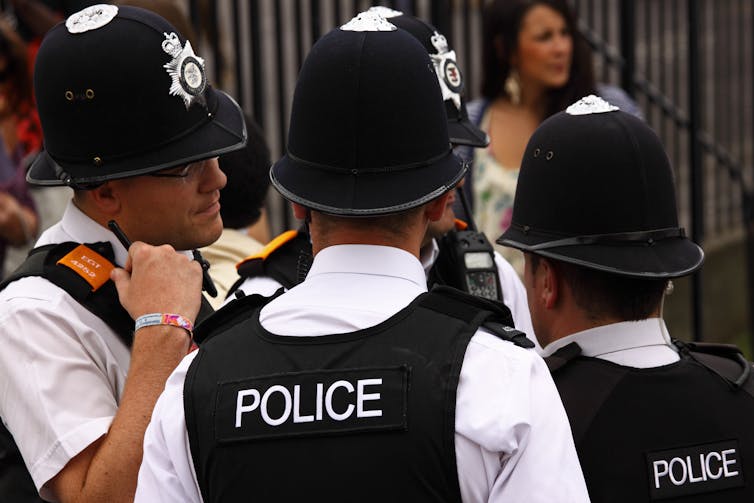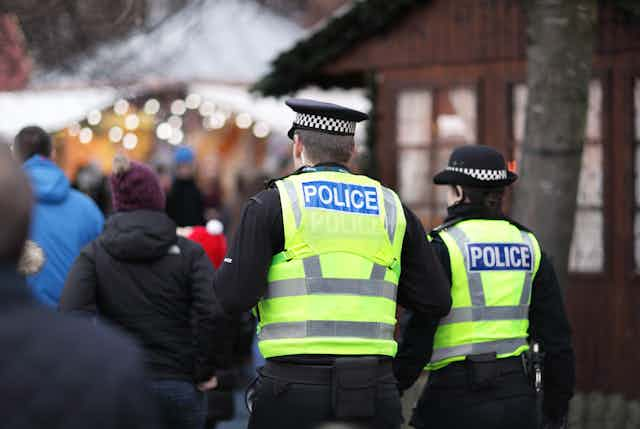The neighbourhood officer was key to the founding tradition of policing in Britain. The concept of “policing by consent” depended on the view of police as citizens in uniform – visible, local figures there to watch, listen and intervene where needed, in a community they knew and understood.
But new figures show that these local, community-focused officers are on the decline in England and Wales. In London, there has been a 64% decline in safer neighbourhood police officers since 2015. Across the country, the figure is 27%.
In 2005, the government introduced the Neighbourhood Policing Programme, recruiting 13,000 police officers and 16,000 Police Community Support Officers over three years. In this model, response policing (when police react to 999 and urgent calls, often with blue lights) was meant to supplement the community policing of the local bobby. But ultimately, it began to replace them.
Investment and police numbers had been going up year-on-year from 2000. But 2010 marked a significant change due to changes in spending. The Institute for Fiscal Studies reports that police funding fell by 14% between 2010 and 2014.
For a while, funding reserves allowed neighbourhood policing to hang on. But steadily, resources were diverted to maintaining emergency response capability. As local councils and other organisations also faced cuts, they too prioritised critical services over preventative safety programmes and youth services.
The number of local police began to fall, and the benefits of a local officer – visibility, reassurance, local knowledge and “nipping things in the bud” eroded. They were replaced with graded response systems and online reporting, given that several police stations closed too.
Declining trust in the police
As a result, an entire generation has grown up not experiencing neighbourhood policing as it had been known the decade before. Relationships were lost and never repaired, and some communities felt abandoned.
The flow of information from the public to the police slowed, as a result of less informal contact between people and their local bobby. As that intelligence dried up, so did the police’s chances of stopping crime. And, up went the confidence of young, experimenting criminals who found they could get away with things easily. Increases in shoplifting and antisocial behaviour are likely due in part to a perceived sense of impunity.
This intelligence is the lifeblood of policing, and relies upon having some sort of relationship of trust, something that is sorely missing in UK policing today.
Trust and confidence in the police has declined in recent years. The crime survey for England and Wales found that overall confidence in local police fell from 78% in 2017-18 to 69% in 2021-22. This has also been influenced by high-profile cases of police misconduct and criminality, such as the murder of Sarah Everard by a serving officer.
The Independent Office for Police Conduct monitors public confidence in policing and has found that 20% of people say an increased local police presence would help improve their confidence.

The changing nature of policing
In 2019, the government pledged to recruit 20,000 officers under the national Uplift programme by March 2023. This goal was achieved, but while new members were joining, existing personnel were retiring and larger numbers were leaving early. The impact, numerically, was blunted.
With resources dwindling since 2010, much policing experience was lost and not replaced. The urgent recruitment campaign from 2019 created young-in-service police teams, often led by inexperienced supervisors, who were often those responding to 999 calls.
Read more: Boris Johnson’s pledge for 20,000 'new' police officers is misleading and problematic – expert
Patterns of offending were changing too, so more specialist policing personnel were allocated to address cybercrime and complex investigations, such as grooming and trafficking.
Police chiefs had to balance priorities and put staff where they were more immediately needed. Neighbourhood patrol functions suffered, and over time, streets started to be lost to gangs who filled that vacuum.
There are now renewed calls, notably from the Labour party, to reinvest in neighbourhood policing, which would start to rebuild the relationships lost over the last bleak decade. This would be welcome, but it would need to include investment in other supporting services too, like youth programmes.
Any new local police teams will face two key challenges. First, they will be building largely from scratch due to the deskilling of those lost years. And they will need to regain trust lost from communities that have grown up without local policing, who have now learned to live without it.

